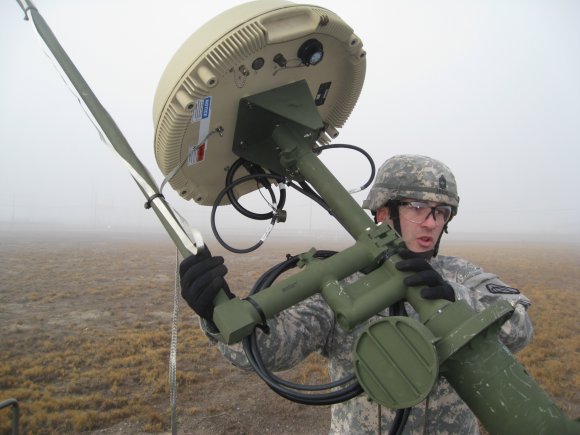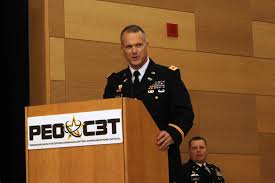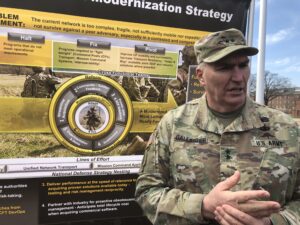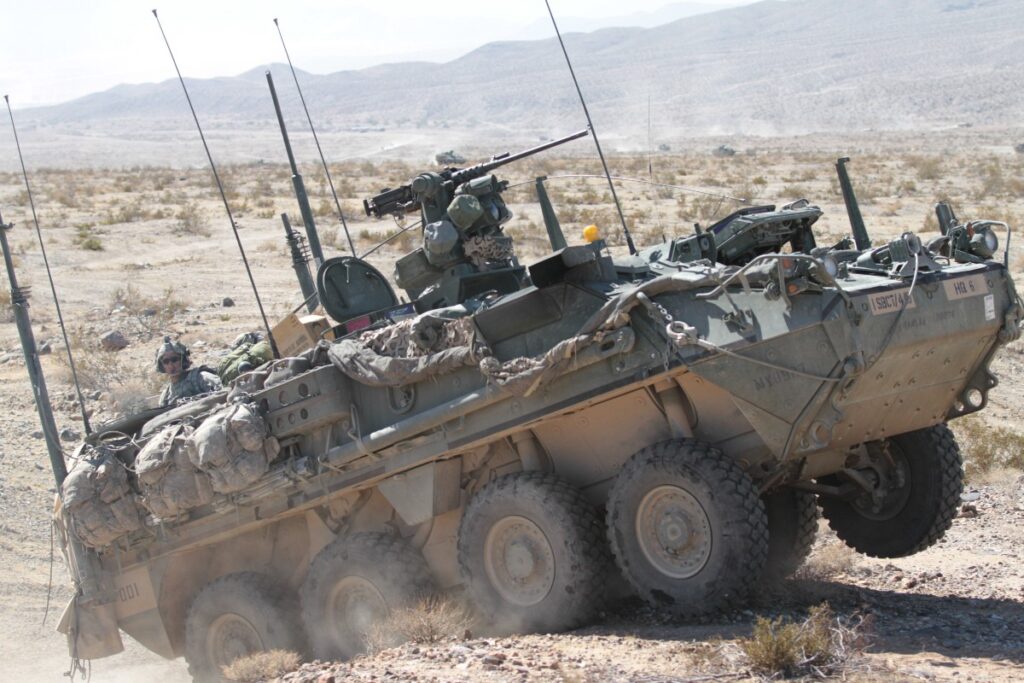
An Army soldier sets up a highband antenna in Afghanistan.
WASHINGTON: The Army’s eager to exploit fast-moving commercial tech, from data fabrics to communications satellites, as it urgently upgrades its battlefield networks. But what works for civilians — or even for the other services — won’t always work for ground troops dispersed across the globe in the mud and dirt.
A simple example? Power cables. “A commercial off-the-shelf cable for a teenager that’s charging their battery while sitting on a couch is probably not the same cable you need when you’re kicking down doors and going through brush,” Brig. Gen. Robert Collins, the Army’s network acquisition chief, said in an interview with Breaking Defense.

Brig. Gen. Robert Collins
Even foot soldiers are increasingly festooned with electronics, from radios to targeting goggles, and they can’t afford cables to come loose or to get snagged in the heat of battle. To find and eliminate those devils in the details, the service is putting the new tech through extensive hands-on field tests with real soldiers.
A complex example? Data fabrics – basically, common standards, formats, and translators to enable previously incompatible systems to share information. That’s essential to the highly connected, artificially intelligent meta-network known as Joint All Domain Command and Control (JADC2), meant to link all the services across land, sea, air, space and cyberspace.
“The network we’re trying to deliver, really, it’s the underpinning of everything related to Joint All Domain Operations,” said Maj. Gen. Peter Gallagher, network modernization chief at Army Futures Command, who spoke to me alongside Collins.

Maj. Gen. Peter Gallagher
Future wide-ranging, fast-moving, far-striking operations require a robust network with plenty of alternate pathways to handle hacking, jamming and vast distances. The Army is busily building its piece of that “tactical grid.” The Army is working particularly closely with the Air Force, Gallagher said, including connecting its Orion Forge DevSecOps environment to the Air Force’s PlatformOne.
Meanwhile, the Joint Staff is working on all-service data standards – but Collins argues that one size does not necessarily fit all. “We may not necessarily have a common singular data fabric but we need the ability to federate these data fabrics,” he said, with the services creating their own individual but compatible fabrics. (The Army’s is called Project Rainmaker).
The Army’s data demands are unique and difficult, Collins said. In a given theater of operations, commanders might need to exchange data amongst hundreds of aircraft and satellites. A single Army combat brigade has to link hundreds of vehicles and thousands of soldiers, all operating at ground level where dust and intervening obstacles – hills, buildings, trees – play havoc with transmissions. That requires a multi-layered and flexible mesh network that can handle surface-to-surface transmissions, surface-to-air, and surface-to-space.
That “space layer” and the new data fabric will get a big workout in the annual Project Convergence wargames this fall.

Stryker vehicle
Project Convergence & Capability Sets
The Army is now upgrading its tactical network on a rapid-fire two-year cycle, with the upgraded Capability Set 21 fielding this year to four light infantry brigades. The 1st Brigade of the 82nd Airborne at Fort Bragg got all its kit by March; the 173rd Airborne in Italy will finish in June; the 3rd Brigade of the 25th Infantry in Hawaii will finish in September; and the 3rd Brigade of the 82nd will be done in December.
Meanwhile, starting in August, the Army will also field CS 21 kit to a brigade mounted in 8×8 Stryker armored vehicles, the Germany-based 2nd Cavalry Regiment, to see how it needs to be adapted for a very different kind of unit.
The Army’s already started testing tech for Capability Set 23, which will focus on the medium-weight Stryker brigades, and it’s looking ahead to CS 25, for heavy armor. Those are all vehicle-mounted formations, which can move much farther and faster than light infantry (although the Army is adding some air-droppable light trucks to infantry units). That means they need longer-ranged communications, which in turn requires heavier use of satellites.
But traditional Geosynchronous Orbit (GEO) communications satellites are so high that it increases lag time and limits bandwidth. So, for CS 23 and 25, the Army is intensely interested in an emerging commercial boom in Low Earth Orbit (LEO) and Medium Earth Orbit (GEO) comsats.
“Gen. Gallagher and I had a chance to go visit SpaceX, and we are watching that one extremely closely,” Collins said.
“A lot of those solutions were not readily available in ’21,” Gallagher told me. “Some of them are emerging now, and we’ve been prototyping low-earth orbit, mid-earth orbit, and some advanced waveforms.”
In last fall’s Project Convergence 20 wargames, the Army demonstrated limited use of LEO and MEO communications, as well as parts of the Project Rainmaker data fabric. In this fall’s Project Convergence 21, he said, they’ll play a much bigger role as an integral part of the battlefield network.
The hard part for the Army isn’t finding the satellites — the private sector is putting more and more in orbit, and the service has no plans to launch its own. The hard part is developing ground terminals that can communicate with all these new satellites without soldiers having to travel with multiple types of kit.
“The last thing we want is a unique terminal for LEO, a unique terminal for MEO,” Collins told me. The Army may never get to a single terminal that meets the needs of all users, he said. A battalion commander has very different demands from a theater headquarters. But it wants to move to a family of compatible terminals, available in different sizes for different users but all equally capable of talking to LEO, MEO, and GEO satellites.
That technology doesn’t exist, yet. Developing it is a daunting challenge, one of many the Army is taking on as it modernizes the network at a breathtaking pace. With upgrades now coming every two years, and heavy use of the latest off-the-shelf commercial technology instead of bespoke military development programs, Collins said, it’s moving “unbelievably faster than how we’ve done things in the past.”
And the service has kept up the pace despite the COVID pandemic. There’s been an intense effort to keep “continuity and momentum,” Gallagher told me. “This team has fought through a lot of obstacles.”






















